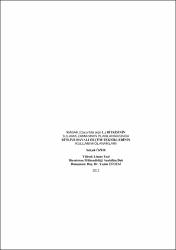| dc.contributor.author | Özer, Selçuk | |
| dc.date.accessioned | 2017-05-11T07:26:07Z | |
| dc.date.available | 2017-05-11T07:26:07Z | |
| dc.date.issued | 2012 | |
| dc.identifier.uri | https://hdl.handle.net/20.500.11776/953 | |
| dc.description.abstract | Bu çalışmada, kabak (Cucurbita pepo L.) bitkisinin Tekirdağ koşullarında, damla sulama yöntemi kullanılarak; verim ve verim öğelerinin belirlenmesi; bitki su tüketimi ve uygun sulama programlarının geliştirilebilmesi için, buharlaşma miktarları ile bitkiye dayalı ölçüm tekniklerinden yararlanılması amaçlanmıştır. Araştırma, 2010 ve 2011 yıllarında yürütülmüş, A sınıfı kaptan olan buharlaşmanın %0, %50, %75, %100 ve %125' i kadar sulama suyunun uygulandığı deneme konularından oluşturulmuştur. Bitki su tüketimi değerleri 2010 yılında 222.4 ? 472.2 mm, 2011 yılında 300.8 - 575.8 mm arasında değişmiştir. Araştırma sonucunda, en yüksek pazarlanabilir kabak verimi, ilk yıl 34.80 t ha-1 ile I125 deneme konusundan, ikinci yıl ise 31.20 t ha-1 ile I100 deneme konusundan elde edilmiştir. Genel olarak farklı sulama uygulamalarının verim ve verim elamanları üzerine istatistiksel açıdan önemli düzeyde etkileri olduğu görülmüştür. Sulama suyu kullanım randımanı (IWUE) değerleri 2010 yılında 4.52 - 10.0 kg m-3, 2011 yılında ise 2.64 ? 4.38 kg m-3 arasında değişirken, su kullanım randımanları (WUE) sırasıyla 7.37 - 8.22 kg m-3 ve 5.40 - 6.19 kg m-3 arasında değişmiştir. Su - üretim sonuçları değerlendirildiğinde, A sınıfı buharlaşma kabından ölçülen buharlaşma değerlerinin %100' ünün uygulandığı deneme konusunun (I100) ön plana çıktığı belirlenmiştir. Çalışmada, beş farklı sulama konusunun; verim ve sayısal yaklaşım ile hesaplanan bitki su stresi indeksi (CWSI) değerlerine etkisi araştırılmıştır. CWSI değerlerinin değişimi, toprak nem içeriğindeki değişimle aynı eğilimi göstermiştir. Topraktaki nem eksikliği arttıkça, CWSI değerlerinde artış görülmüştür. Verim değerleri ile ortalama CWSI değerleri arasında verim tahmininde kullanılabilecek "Y = -37.12 CWSI + 44.475" ve "Y = -18.338 CWSI + 34.726" doğrusal eşitlikleri elde edilmiştir. Sonuçta, bitki su stresi indeksi değerlerinden sulama zamanının belirlenmesinde ve kabağın verim tahmininde yararlanılabileceği belirlenmiştir. Ayrıca, bitki su stresi indeksi ile yaprak alan indeksi arasında önemli ilişkiler elde edilmiştir. | en_US |
| dc.description.abstract | The aim of this study was to evaluate yield response functions, evapotranspiration and irrigation scheduling of summer squash (Cucurbita pepo L.) in Tekirdag region. For this purpose, using drip irrigation techniques, evaporation have been established taking advantage of plant-based measurement techniques. Field trials were conducted during the year 2010 and 2011 growth period. The amount of irrigation water volume was the treatments of the study as 0%, 50%, 75%, 100% and 125% of the water amount evaporated from class A pan. The measured crop evapotranspiration for the 2010 and 2011 years changed as 222.4 - 472.2 mm and 300.8 ? 575.8 mm, respectively. As a result of research, the greatest squash yield was obtained in the first year from I125 treatment as 34.80 t ha-1 and the second year from I100 treatment as 31.20 t ha-1. Generally, the effects of irrigation programs on yield and yield parameters were statistically significant. Irrigation water use efficiency (IWUE) changed as 4.52 - 10.0 kg m-3 in 2010 and 2.64 - 4.38 kg m-3 in 2011, while water use efficiency (WUE) changes as 7.37 - 8.22 kg m-3 and 5.40 - 6.19 kg m-3, respectively. As the results of water - production parameters are evaluated, the treatment which is 100% of the water amount evaporated from class A pan (I100) has been come to the fore. The effects of five irrigation levels on yields and resulting CWSI which was calculated by using the empirical approach were also investigated. The trends in CWSI values were consistent with the soil water content induced by deficit irrigations. Unlike the yield, CWSI increased with increased soil water deficit. The yield was directly correlated with mean CWSI values and the linear equations "Y = -37.12 CWSI + 44.475" ve "Y = -18.338 CWSI + 34.726" can be used for yield prediction. The CWSI value was useful for evaluating crop water stress in squash and should be useful for timing irrigation and predicting yield. Moreover, statistically significant correlations were found between CWSI and leaf area index (LAI). | en_US |
| dc.language.iso | tur | en_US |
| dc.publisher | Namık Kemal Üniversitesi | en_US |
| dc.rights | info:eu-repo/semantics/openAccess | en_US |
| dc.subject | Yazlık Kabak (Cucurbita pepo L.) | en_US |
| dc.subject | su-üretim fonksiyonları | en_US |
| dc.subject | bitki su tüketimi | en_US |
| dc.subject | bitki su stresi indeksi (CWSI) | en_US |
| dc.subject | Summer Squash (Cucurbita pepo L.) | en_US |
| dc.subject | water - yield production functions | en_US |
| dc.subject | evapotranspiration | en_US |
| dc.subject | crop water stress index (CWSI) | en_US |
| dc.title | Kabak (Cucurbita pepo L.) bitkisinin sulama zamanının planlanmasında bitkiye dayalı ölçüm tekniklerinin kullanım olanakları | en_US |
| dc.title.alternative | Usage of possibilities plant-based measurement techniques on irrigation scheduling of summer squash (Cucurbita pepo L.) | en_US |
| dc.type | masterThesis | en_US |
| dc.department | Enstitüler, Fen Bilimleri Enstitüsü, Biyosistem Mühendisliği Ana Bilim Dalı | en_US |
| dc.relation.publicationcategory | Tez | en_US |



















